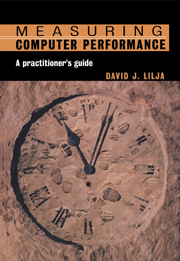Book contents
- Frontmatter
- Contents
- Preface
- Acknowledgements
- 1 Introduction
- 2 Metrics of performance
- 3 Average performance and variability
- 4 Errors in experimental measurements
- 5 Comparing alternatives
- 6 Measurement tools and techniques
- 7 Benchmark programs
- 8 Linear-regression models
- 9 The design of experiments
- 10 Simulation and random-number generation
- 11 Queueing analysis
- Appendix A Glossary
- Appendix B Some useful probability distributions
- Appendix C Selected statistical tables
- Index
4 - Errors in experimental measurements
Published online by Cambridge University Press: 15 December 2009
- Frontmatter
- Contents
- Preface
- Acknowledgements
- 1 Introduction
- 2 Metrics of performance
- 3 Average performance and variability
- 4 Errors in experimental measurements
- 5 Comparing alternatives
- 6 Measurement tools and techniques
- 7 Benchmark programs
- 8 Linear-regression models
- 9 The design of experiments
- 10 Simulation and random-number generation
- 11 Queueing analysis
- Appendix A Glossary
- Appendix B Some useful probability distributions
- Appendix C Selected statistical tables
- Index
Summary
‘To free a man of error is to give, not to take away. Knowledge that a thing is false is a truth.’
SchopenhauerAccuracy, precision, and resolution
In trying to measure and understand the performance of computer systems, we are constantly confronted by the nitty-gritty details of the real world. Unfortunately, these annoying details effectively introduce uncertainty into our measurements. We refer to these uncertainties in measurements as errors or noise. To determine how much uncertainty exists in our measurements, and, therefore, to determine what conclusions we can actually draw from them, we must use the tools and techniques of probability and statistics to quantify the errors.
We learned in previous chapters that time is a fundamental quantity that needs to be measured to determine almost any aspect of a computer system's performance. Any measurement tool, such as the interval timer, has three important characteristics that determine the overall quality of its measurements. The first is its accuracy. In the case of the timer, accuracy is an indication of the closeness of the timer's measurement to that of a standard measurement of time defined by a recognized standards organization, such as the United States National Institute of Standards and Technology. More generally, accuracy is the absolute difference between a measured value and the corresponding reference value. Note that the reference value is an agreed-upon standard, such as the duration of a second, the length of a meter, and so on, that is typically derived from some physical phenomenon.
The second important characteristic of a measurement tool is its precision. Precision relates to the repeatability of the measurements made with the tool.
- Type
- Chapter
- Information
- Measuring Computer PerformanceA Practitioner's Guide, pp. 43 - 60Publisher: Cambridge University PressPrint publication year: 2000

